Global and China Automotive Operating System (OS) Industry Report, 2023-2024
Chinese operating systems start to work hard
In 2023, Chinese providers such as Huawei, Banma Zhixing, Xiaomi, and NIO made efforts in operating system market, launched different versions with competitive advantages, adapting to Chinese chip solutions and obtaining designated projects from OEMs.
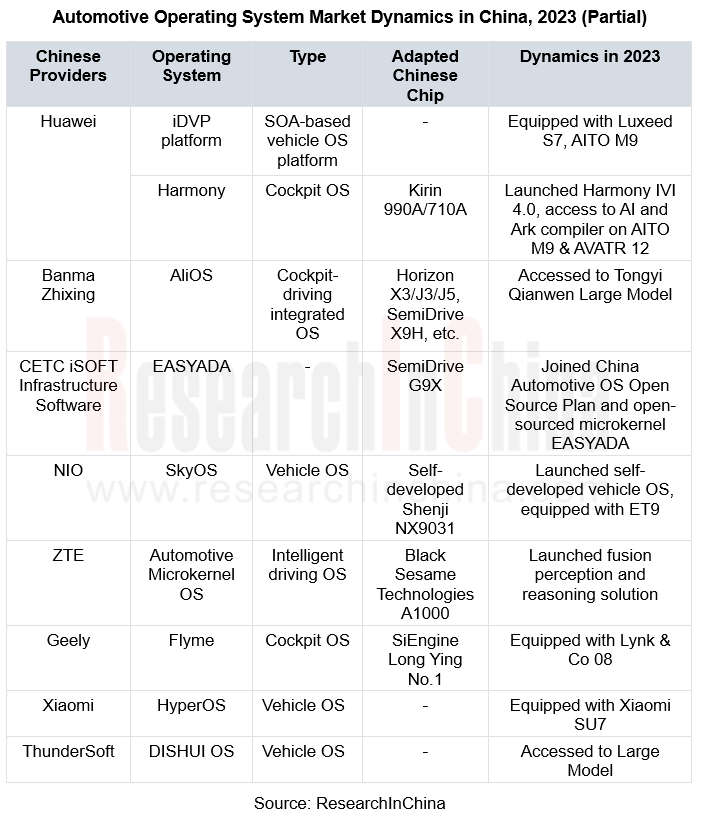
For example, Xiaomi, NIO, etc. have launched vehicle operating systems, and providers such as iSOFT and ZTE have strengthened real-time, security and other functions of operating system microkernel.
In October 2023, Xiaomi launched its self-developed HyperOS, with the underlying layer uses fusion of Linux and Vela kernels, middleware access to AI subsystem, setting priorities in multitasking process, and adopts level scheduling to improve operating system processing efficiency.
In terms of ecosystem, Xiaomi has created the CarIoT ecosystem, which connects Internet IoT and automobile field, realizing concept of "full ecosystem of people, vehicle and home".
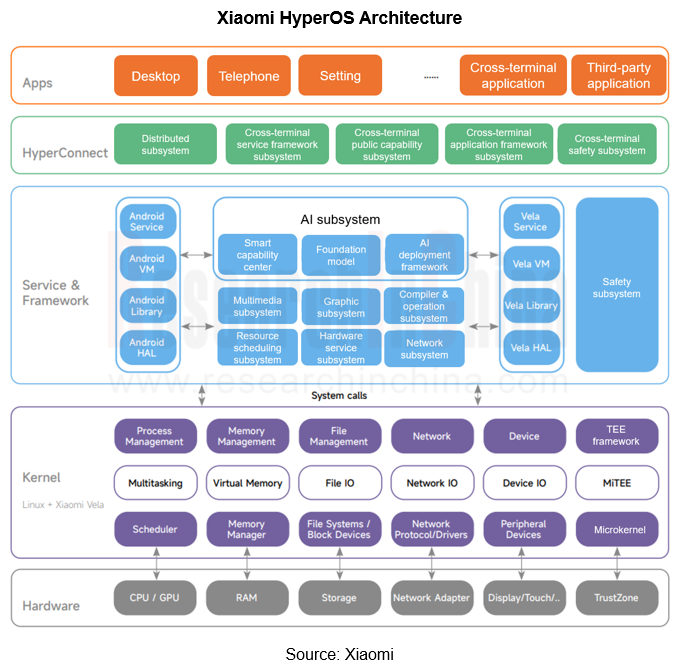
In middleware, AUTOSAR is still one of choices of most OEMs for vehicle control and autonomous driving. But it is not fully adapted to domestic chips, and feedback time of on-site communication processing is longer, which can't fully meet requirements of auto companies, resulting in partial providers and OEMs researching their own microkernel and middleware. In May 2023, China Association of Automobile Manufacturers (CAAM) formally released the first microkernel open-source project of China Automotive Operating System Open Source Plan, which plans to realize independent automotive OS based on open source microkernel and gradually replace QNX in 2025. Among them, iSOFT provided open source microkernel using the Mulan Public License (version 2); SemiDrive Technology provided G9X chip.
EasyAda microkernel provided by iSOFT can provide secure kernels for various chip platforms and application scenarios. For automotive field, iSOFT has implemented corresponding real-time improvement mechanisms for microkernel. For example, priority-based preemption mechanism for large-scale calculations of autonomous driving, preemption scheduling strategy of microkernel, as well as integrated algorithm, interrupt, delay mechanism and other technical means can improve microkernel to break through real-time and performance requirements.
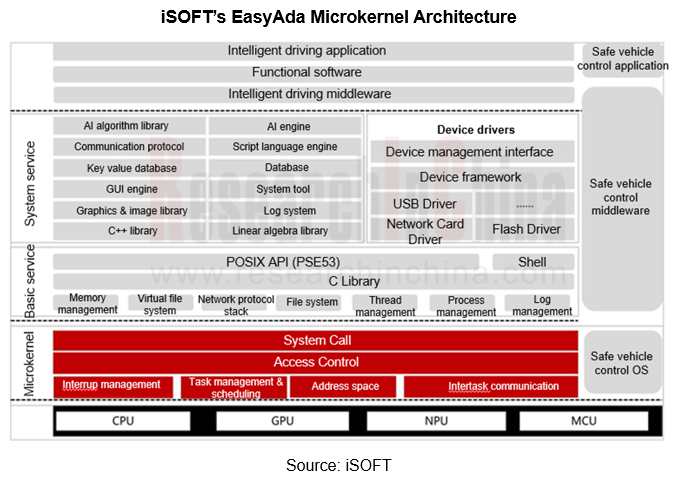
OEMs: three methods to realize vehicle operating systems
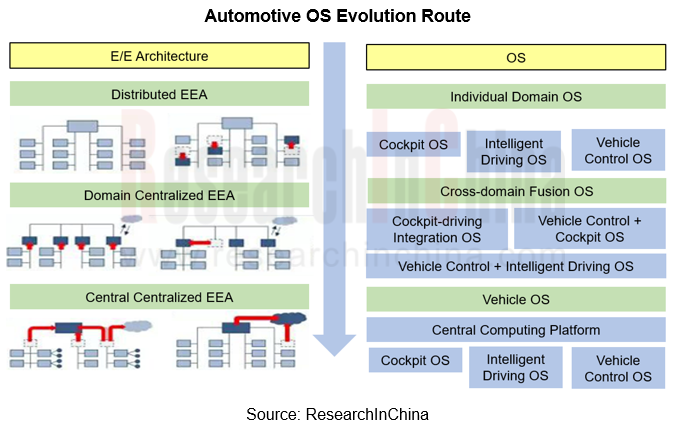
As EE architecture evolves towards a centralized computing architecture, software systems begin to move towards an SOA architecture, where operating systems begin to progress from domain-type to vehicle-level.
SOA-based vehicle operating system integrates functions of cockpit OS, intelligent driving OS, and safety vehicle control OS via central computing platform to provide vehicle-level platform with a set of programming interfaces. Characterized by layered decoupling and unified architecture, it improves development efficiency of auto companies via providing unified interfaces. Vehicle operating system realizes functions scheduling and integration in various domains of the vehicle by centrally scheduling hardware resources and computing power.
According to ResearchInChina, there are three methods to implement vehicle operating system:
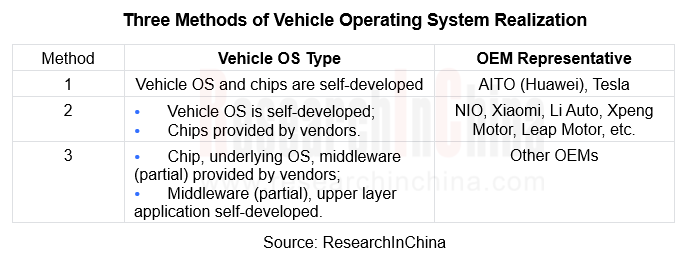
Method 1, Huawei:
In April 2023, Huawei launched iDVP Intelligent Digital Vehicle Platform (i.e., vehicle operating system), which is a digital base designed based on SOA architecture, integrating functions of Huawei's various domain operating systems (AOS, HOS, and VOS), and realizing decoupling of software and hardware through atomic service layer, thus realizing rapid adaptation for cross-model development.
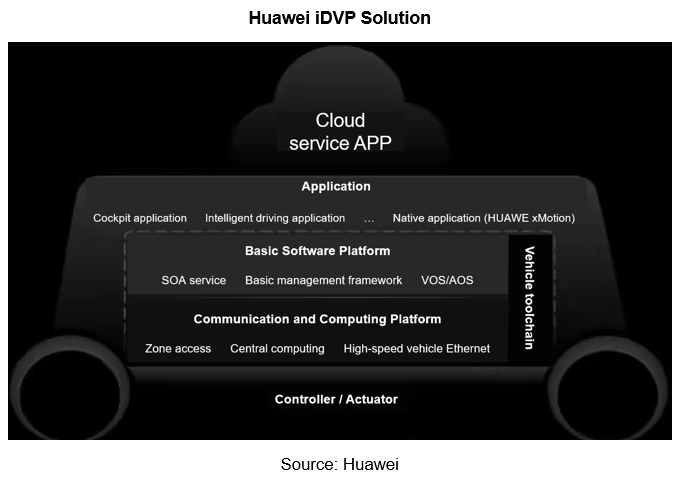
In 2023, representative model were AITO M9 and Luxeed S7, whose Toulin chassis is developed based on iDVP and realizes centralized and collaborative control of vehicle driving, braking, steering, and suspension through native applications such as HUAWEI xMotion configured with iDVP. In 2024, iDVP platform is scheduled to launch seven vehicles.
Method 2, NIO:
In September 2023, NIO released vehicle operating system "SkyOS", using self-developed microkernel and Hypervisor to replace QNX kernel service. SkyOS is divided into four modules, of which SkyOS-M module is based on a self-developed microkernel and has strong real-time performance and security. Its microkernel architecture is equipped with Hypervisor system for cockpit-driving integration, which is installed on NIO NT 3.0 platform; SkyOS-L module uses a self-developed middleware platform to replace AUTOSAR solution.
During OS development, NIO has released a number of technologies, including those for realizing task scheduling on multi-core processing system and improving task scheduling efficiency. Among them, multi-layer scheduling model is adopted for scheduling target tasks on multi-core processing system. equipped with fair round robin algorithm/most idle priority algorithm, etc., the vehicle operating system is able to coordinate hardware resources (computing power, sensors) under different working conditions by means of perception function groups.
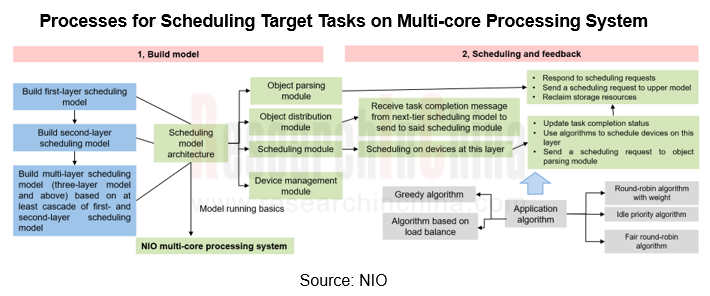
Linux, Harmony, SkyOS and other operating systems use different scheduling methods for multitasking, and evolved from initial unified scheduling to multi-layer scheduling, which improves processing efficiency, as well as security performance.
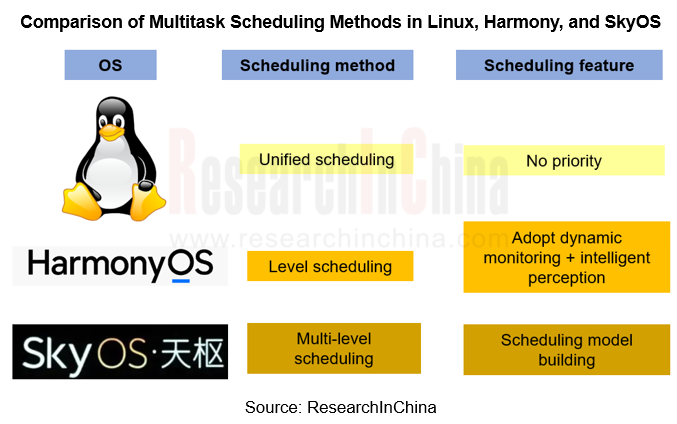
Method 3, Volkswagen:
Volkswagen VW.OS consists of SDK (Software Development Kit), reference applications, software components and configuration tools for embedded software and cloud connectivity. By working in conjunction with VW.AC and BigLoop, it forms a vehicle software development platform that realizes conversion of distributed to centralized processing methods and achieves a core architecture reduction to three in-vehicle central processors.
As of February 2023, some Porsche and Audi models already carry partial components of VW.OS 1.2 (including software updates, cloud-based data transfer, diagnosis, and data accumulation), and Volkswagen plans to roll out the full software platform as version 2.0 in 2025, with partners including BlackBerry and Microsoft.
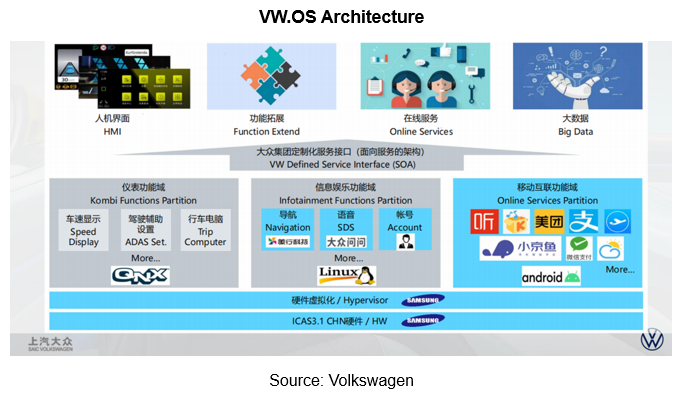
Providers: building an OS ecosystem
OS large-scale application requires the support of a strong ecosystem. In 2023, while actively implementing vehicle operating systems, automotive OS providers will also increase expansion of OS ecosystem, including adapting to more domestic chips and establishing more upstream and downstream partners.
Upstream/downstream cooperation:
ThunderSoft: worked closely with its subsidiary DISHUI Zhixing and Lingang section of Shanghai Pilot Free Trade Zone to set up a vehicle R&D base; in addition, ThunderSoft and Cariad, a subsidiary of Volkswagen, established Carthunder as a joint venture to cooperate in the fields of intelligent connectivity, intelligent cockpit, and operating system.
ArcherMind Technology: established a strategic partnership with EB in AUTOSAR.
Chip:
ThunderSoft: ThunderSoft is deeply bound to Qualcomm chips. For example, it has achieved stable operation of the LLaMA-2 13 billion parameter model on edge devices equipped with Qualcomm 8 series chip platforms, and improved competitiveness of vehicle platform products through AI large models.
ArcherMind Technology: In 2023, ArcherMind Technology built a Hesper OS software platform solution for J5 and J6 based on Horizon TogetherROS.Auto platform. This solution adds SOA functions based on FusionDrive functions. In addition, ArcherMind Technology signed a cooperation agreement with NVIDIA to become its ecosystem software partner, providing intelligent driving vision solutions based on Orin and Xavier chips to intelligent driving-related companies.
Build a developer ecosystem: Huawei, for example, launched HarmonyOS NEXT and provides middleware and tool chains for developers.
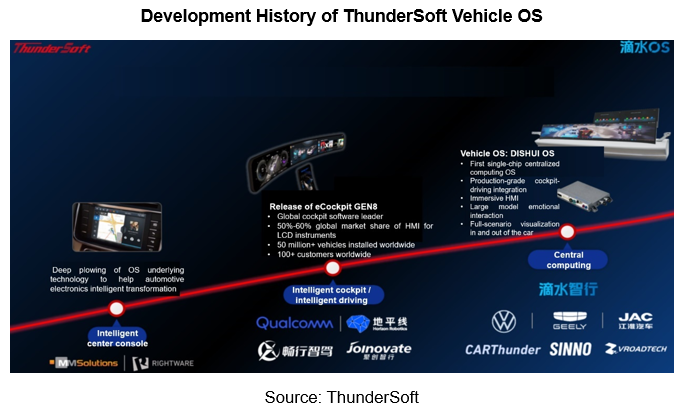
OEMs and Tier 1 Suppliers' Cost Reduction and Efficiency Enhancement Strategy Analysis Report, 2025
ResearchInChina released the "OEMs and Tier 1 Suppliers' Cost Reduction and Efficiency Enhancement Strategy Analysis Report, 2025", summarizing hundreds of cost reduction strategies to provide referen...
Automotive Fixed Panoramic Sunroof and Smart Roof Research Report, 2025
With the intelligent application of car roofs as the core, this report systematically sorts out a series of new products such as fixed panoramic sunroof/openable sunroof, ceiling screen, roof ambient ...
Automotive-Grade Power Semiconductor and Module (SiC, GaN) Industry Research Report, 2025
SiC/GaN Research: Sales volume of 800V+ architecture-based vehicles will increase more than 10 times, and hybrid carbon (SiC+IGBT) power modules are rapidly being deployed in vehicles.
Sales volume o...
Cockpit Agent Engineering Research Report, 2025
Cockpit Agent Engineering Research: Breakthrough from Digital AI to Physical AI
Cockpit Agent Engineering Research Report, 2025 starts with the status quo of cockpit agents, summarizes the technical ...
Prospective Study on L3 Intelligent Driving Technology of OEMs and Tier 1 Suppliers, 2025
L3 Research: The Window of Opportunity Has Arrived - Eight Trends in L3 Layout of OEMs and Tier 1 Suppliers
Through in-depth research on 15 OEMs (including 8 Chinese and 7 foreign OEMs) and 9 Tier 1 ...
China Commercial Vehicle IoV and Intelligent Cockpit Industry Research Report 2025
Commercial Vehicle IoV and Cockpit Research: The Third Wave of Passenger Car/Commercial Vehicle Technology Integration Arrives, and T-Box Integrates e-Call and 15.6-inch for Vehicles
I. The third wav...
Intelligent Vehicle Electronic and Electrical Architecture (EEA) and Technology Supply Chain Construction Strategy Research Report, 2025
E/E Architecture Research: 24 OEMs Deploy Innovative Products from Platform Architectures to Technical Selling Points
According to statistics from ResearchInChina, 802,000 passenger cars with domain...
Research Report on Intelligent Vehicle Cross-Domain Integration Strategies and Innovative Function Scenarios, 2025
Cross-Domain Integration Strategy Research: Automakers' Competition Extends to Cross-Domain Innovative Function Scenarios such as Cockpit-Driving, Powertrain, and Chassis
Cross-domain integration of ...
China Autonomous Driving Data Closed Loop Research Report, 2025
Data Closed-Loop Research: Synthetic Data Accounts for Over 50%, Full-process Automated Toolchain Gradually Implemented
Key Points:From 2023 to 2025, the proportion of synthetic data increased from 2...
Automotive Glass and Smart Glass Research Report, 2025
Automotive Glass Report: Dimmable Glass Offers Active Mode, Penetration Rate Expected to Reach 10% by 2030
ResearchInChina releases the Automotive Glass and Smart Glass Research Report, 2025. This r...
Passenger Car Brake-by-Wire (BBW) Research Report, 2025
Brake-by-Wire: EHB to Be Installed in 12 Million Vehicles in 2025
1. EHB Have Been Installed in over 10 Million Vehicles, A Figure to Hit 12 Million in 2025.
In 2024, the brake-by-wire, Electro-Hydr...
Autonomous Driving Domain Controller and Central Computing Unit (CCU) Industry Report, 2025
Research on Autonomous Driving Domain Controllers: Monthly Penetration Rate Exceeded 30% for the First Time, and 700T+ Ultrahigh-compute Domain Controller Products Are Rapidly Installed in Vehicles
L...
China Automotive Lighting and Ambient Lighting System Research Report, 2025
Automotive Lighting System Research: In 2025H1, Autonomous Driving System (ADS) Marker Lamps Saw an 11-Fold Year-on-Year Growth and the Installation Rate of Automotive LED Lighting Approached 90...
Ecological Domain and Automotive Hardware Expansion Research Report, 2025
ResearchInChina has released the Ecological Domain and Automotive Hardware Expansion Research Report, 2025, which delves into the application of various automotive extended hardware, supplier ecologic...
Automotive Seating Innovation Technology Trend Research Report, 2025
Automotive Seating Research: With Popularization of Comfort Functions, How to Properly "Stack Functions" for Seating?
This report studies the status quo of seating technologies and functions in aspe...
Research Report on Chinese Suppliers’ Overseas Layout of Intelligent Driving, 2025
Research on Overseas Layout of Intelligent Driving: There Are Multiple Challenges in Overseas Layout, and Light-Asset Cooperation with Foreign Suppliers Emerges as the Optimal Solution at Present
20...
High-Voltage Power Supply in New Energy Vehicle (BMS, BDU, Relay, Integrated Battery Box) Research Report, 2025
The high-voltage power supply system is a core component of new energy vehicles. The battery pack serves as the central energy source, with the capacity of power battery affecting the vehicle's range,...
Automotive Radio Frequency System-on-Chip (RF SoC) and Module Research Report, 2025
Automotive RF SoC Research: The Pace of Introducing "Nerve Endings" such as UWB, NTN Satellite Communication, NearLink, and WIFI into Intelligent Vehicles Quickens
RF SoC (Radio Frequency Syst...